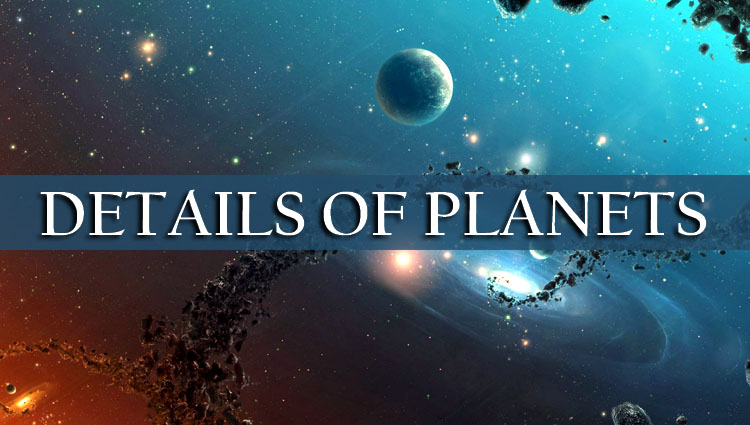DETAILS OF PLANETS | Geography
Mercury | DETAILS OF PLANETS
Nearest to the Sun, smallest and fastest planet. It takes 8 8 days to complete one revolution of the sun. Life is not possible on this planet because of the absence of atmosphere. This member of the solar family has no natural satellite. Mariner-10 was the only artificial satellite.
Venus| DETAILS OF PLANETS
Brightest, hottest, closest to earth and earth nears twin planet. It is the Second closest planet to the Sun. This planet, unlike other planets, goes around the Sun from east to west and is the nearest planet to the Earth, it is the brightest object seen in the sky, after the Sun and the Moon therefore it is called ‘Morning star’ is well as ‘Evening star’. Being almost similar to the Earth in size and mass it is also called the sister planet of the Earth.
Earth| DETAILS OF PLANETS
Most dense planet, watery planet and Bios planet. it rotates on its axis from west to east. It is tilted on its axis by 23%. It takes about 365% days to complete one revolution around the sun. Its average distance from the sun is about 150 million km. It looks blue when seen from the outer space due to the presence of large amount of water, hence it is also called the ‘Blue Planet’.
Mars| DETAILS OF PLANETS
Meaning god of war, ‘Red Planet’. It is called ‘Red Planet’ because of its red appearance. It is the only planet, besides earth, where the possibility of life exists, because of the presence of atmosphere and glacial water as observed by the artificial satellite, ‘Mars Odyssey’. Its rotation is like that the earth. It has two natural staellites-Phobos and Domos, the smallest satellites of the solar system. The highest point on this planet is Nicks Olympia which is three times as high as Mt. Everest.
Read also: 10 Surprising Facts About the Human Brain You Didn’t Know
Jupiter| DETAILS OF PLANETS
Largest Planet, largest no. of satellites and smallest day. This is the largest planet of the solar system. It has 28 natural satellites going around it wherein Ganymede is the largest satellite of the planet as well as of the solar system. Ayo, Europa, Calisto, Almethia, etc are other satellites. The atmosphere of the planet is composed of Hydrogen, Helium, Methane and Ammonia. It possesses the qualities of both a planet and a star, as it has its own radio energy. Its most distinguish feature is the great red spot, which is believed to be a complex storm in the atmosphere of the planet.
Saturn| DETAILS OF PLANETS
Least dense, floating planet on water (because of low density than water). Its most spectacular and mysterious characteristic is the presence of fully developed rings around it. These rings are composed of Small particles, which go around this planet collectively, due to its gravitational force. It is also called the ‘Gaseous Globe’ Galaxy like Planet. It appears yellow in the sky.
Like Jupiter, the atmosphere os Saturn is also composed of Hydrogen, Helium, Methane. 30 Natural satellites of this planet have been discovered, till date, of which Titan is the largest, having the size. comparable to Mercury and its Own atmosphere and the gravitational force.
Other satellites of Saturn included Mimansa, Ensiladu, Tethys, Phobe etc. Saturn is the last planet of the solar system that can be seen through the naked eyes.
Check also: World General Knowledge MCQs
Uranus| DETAILS OF PLANETS
Lightest of the outer planets. Uranus was discovered by Herschel in 1781. Due to higher inclination of axis, it is also known as ‘Lying Planet’. The Sun rises in its west and sets in its east. It appears green
Neptune| DETAILS OF PLANETS
Coldest, slowest to move round the sun and largest year. Neptune was discovered by Galle in 1846. It appears light yellow in colour
Check Other World General Knowledge Notes
- Global Giants: Exploring Prominent International Organizations
- 10 Surprising Facts About the Human Brain You Didn’t Know
- World Labour Day Tribute: Honouring Workers
- World Health Day | Building a Fairer, Healthier World
- The World Wars: A Global Struggle for Power and Ideology
- Important World General Knowledge One Liners
- An Overview of the Punjab Assembly: How it Works and what it does
- 10 Attractive Facts About Pakistan You Must Know
- Universe Short Question Answer (Set-I) | World General Knowledge
- Handwritten Notes for FIA Tests (PDF File)







